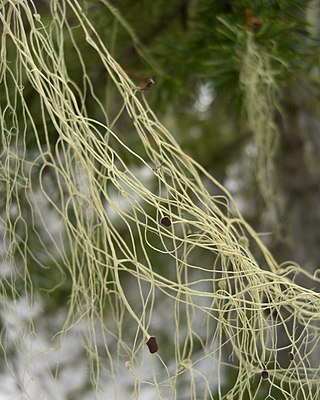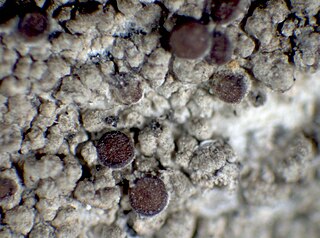
The Sphaerophoraceae are a family of lichen-forming fungi in the order Lecanorales. Species of this family have a widespread distribution, especially in southern temperate regions, with particular diversity in cool temperate rainforests and highly oceanic areas of both hemispheres.

Gloeoheppiaceae is a family of ascomycete fungi in the order Lichinales. The family contains ten species distributed amongst three genera. Most species are lichenised with cyanobacteria. Species in this family are mostly found in desert areas. Modern molecular phylogenetics analysis casts doubt on the phylogenetic validity of the family, suggesting a more appropriate placement of its species in the family Lichinaceae.

Herteliana is a genus of lichen-forming fungi. It contains four species of crustose lichens.
Gallaicolichen is a fungal genus that contains the single species Gallaicolichen pacificus, a foliicolous (leaf-dwelling) lichen. Originally discovered in Hawaii in 2007, G. pacificus has since been found in various locations across the Pacific, including Australia, New Caledonia, Vanuatu, the Philippines, and Japan. The lichen forms small, pale greenish-yellow to yellowish-grey patches on leaves, typically in mid-altitude forests and along forest edges. G. pacificus is notable for its unique reproductive structures called peltidiangia, which produce disc-shaped propagules (peltidia) for asexual reproduction. Initially, its taxonomic classification was uncertain, but recent discoveries of specimens with sexual reproductive structures have enabled scientists to confidently place it within the family Porinaceae.
Stromatella bermudana is a saxicolous (rock-dwelling) crustose lichen. It is the only species in Stromatella, a monotypic fungal genus in the family Lichinaceae.

Alectoria is a genus of fruticose lichens belonging to the family Parmeliaceae.
Ertzia is a monospecific genus in the family Lepidostromataceae. The sole species is Ertzia akagerae, a basidiolichen. The genus was circumscribed in 2014 by Brendan Hodkinson and Robert Lücking. Ertzia is distinguished from all other lichenized clavarioid fungi by having a microsquamulose thallus that forms contiguous glomerules with a cortex of jigsaw puzzle-shaped cells. Ertzia akagerae grows on soil in the African tropics.
Sulzbacheromyces is a genus of basidiolichens in the family Lepidostromataceae. The genus is distinguished from the other genera of Lepidostromataceae by having an entirely crustose thallus and from Multiclavula (Cantharellales) by having a chlorococcoid photobiont. The type species grows on soil in the neotropics.

Hydropunctaria is a genus of saxicolous (rock-dwelling), crustose lichens in the family Verrucariaceae. The genus includes both aquatic and amphibious species, with members that colonise either marine or freshwater habitats. The type species, Hydropunctaria maura, was formerly classified in the large genus Verrucaria. It is a widely distributed species common to littoral zones. Including the type species, five Hydropunctaria lichens are considered marine species: H. adriatica, H. amphibia, H. aractina, H. orae, and H. oceanica.

Mastodia is a genus of lichen-forming fungi in the family Verrucariaceae. It has six species.
Crittendenia is a genus of lichenicolous (lichen-dwelling) fungi in the monogeneric family Crittendeniaceae. The genus was circumscribed in 2021 to contain two species, C. lichenicola, and the type, C. coppinsii; these species were previously classified in the genus Chionosphaera. An additional 16 species were added to the genus the following year. The genus name honours British lichenologist Peter Crittenden.

Botryolepraria is a genus of saxicolous (rock-dwelling), byssoid (cottony) lichens of uncertain familial placement in the order Verrucariales. It has two species. Both species grow in damp conditions, such as on cave walls, particularly in areas with minimal light.
Racoleus is a genus of two species of lichen-forming fungi of uncertain familial placement in the order Capnodiales. Both species of Racoleus are filamentous lichens with Trentepohlia as the photobiont partner. The lichens form thalli in the form of felt-like, blackish-brown cushions that grow under shaded conditions on siliceous rocks.

Myochroidea is a genus of lichen-forming fungi of uncertain familial placement in the order Lecanorales. It has four species of grey or brown-grey crustose lichens.

Puttea is a genus of lichen-forming fungi with uncertain familial placement in the order Lecanorales. The genus comprises four species. Finnish lichenologists Soili Stenroos and Seppo Huhtinen established the genus Puttea in 2009 for the lichen species formerly known as Lecidea margaritella, which has undergone various reclassifications. Molecular phylogenetics analyses have shown that Puttea margaritella does not align closely with genera like Fellhanera or Micarea, but its precise familial placement remains uncertain. Puttea is characterized by an indistinct, lichenized thallus composed of delicate fungal filaments and small algal cells. Its minute, round, whitish apothecia lack a distinct margin, and the asci, or spore-producing cells, are thick-walled, club-shaped, and contain eight spores, showing specific reactions with iodine-based stains. The type species of the genus, Puttea margaritella, typically inhabits boreal forests, growing on the liverwort species Ptilidium pulcherrimum and sometimes on decaying wood or bark. Initially thought to be confined to Europe, it has since been found in North America, particularly in Alaska and Québec, extending its known range. The species is parasitic, damaging its host, and is considered rare within its distribution.
Pseudoheppia is a fungal genus in the family Lichinaceae. It contains a single species, Pseudoheppia schuleri, a saxicolous (rock-dwelling) squamulose lichen.

Gloeoheppia is a genus of lichen-forming fungi in the family Gloeoheppiaceae. It comprises five species. The genus is distinguished from similar-looking lichens like Heppia by its internal structure, the nature of its photobiont, and details of its reproductive structures.
Nebularia is a small genus of lichen-forming fungi in the family Pannariaceae. It comprises two species, both of which are found in the Andes.
Lithocalla is a small genus of lichen-forming fungi in the family Ramalinaceae. It comprises two known species that form crust-like growths with a powdery texture on rocks. The genus was established in 2020 based on genetic analysis of species previously classified under different genera. Lithocalla lichens are characterised by their pale yellow-green colour and their preference for sheltered, shaded rock surfaces. They lack visible reproductive structures and likely spread through fragmentation. The two species have distinct geographical distributions: L. ecorticata is found mainly in Great Britain and Norway, while L. malouina is native to the Falkland Islands.








